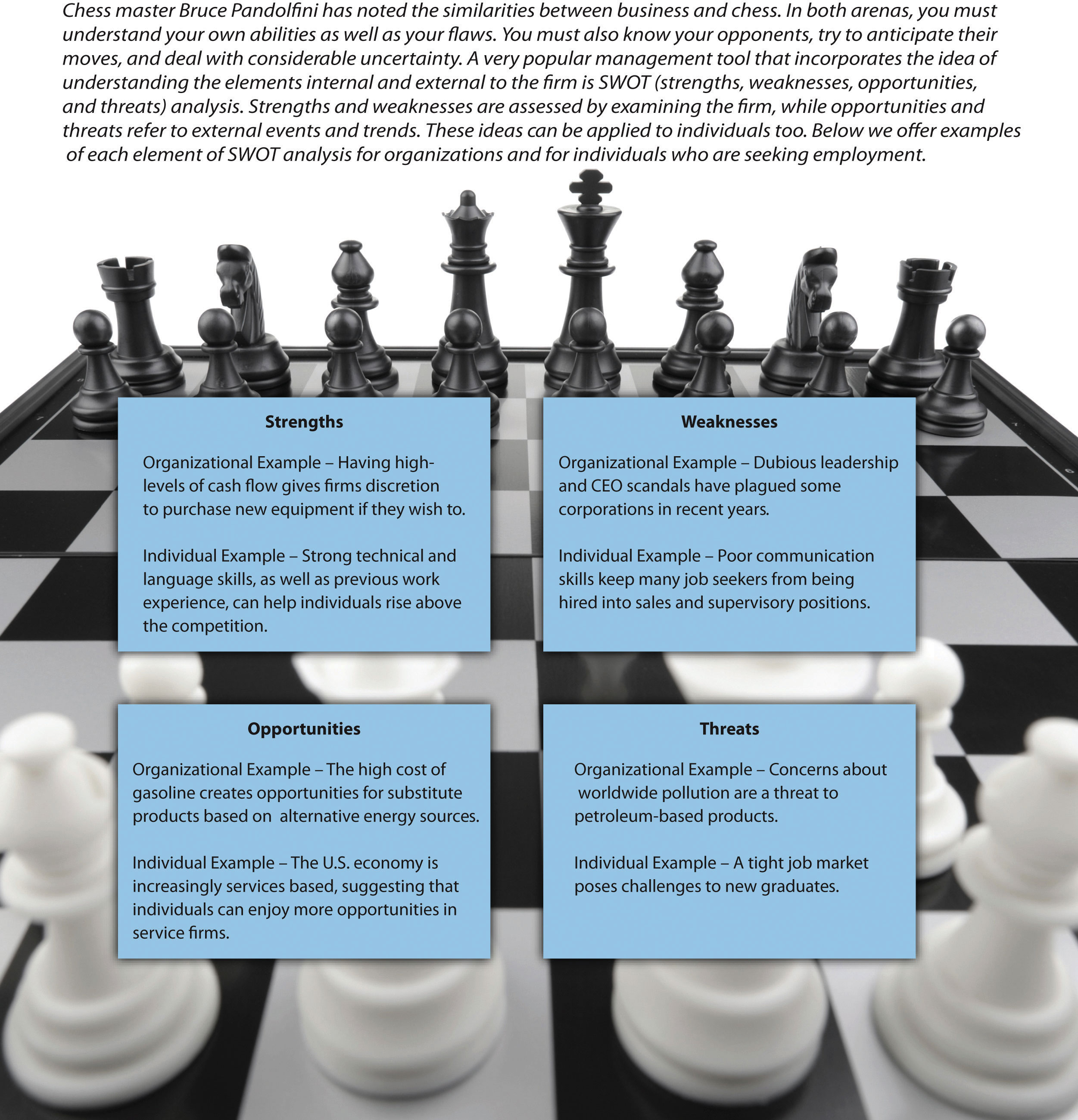This is “SWOT Analysis”, section 4.5 from the book Strategic Management: Evaluation and Execution (v. 1.0). For details on it (including licensing), click here.
For more information on the source of this book, or why it is available for free, please see the project's home page. You can browse or download additional books there. To download a .zip file containing this book to use offline, simply click here.
4.5 SWOT Analysis
Learning Objectives
- Understand what SWOT analysis is.
- Learn how SWOT analysis can help organizations and individuals, and its limitations.
Figure 4.12 SWOT

© Thinkstock
Five forces analysis examines the situation faced by the competitors in an industry. Strategic groups analysis narrows the focus by centering on subsets of these competitors whose strategies are similar. SWOT analysisA technique for understanding a firm’s situation by considering its strengths and weaknesses, along with the opportunities and threats that exist in the firm’s environment. takes an even narrower focus by centering on an individual firm. Specifically, SWOT analysis is a tool that considers a firm’s strengths and weaknesses along with the opportunities and threats that exist in the firm’s environment (Figure 4.12 "SWOT").
Executives using SWOT analysis compare these internal and external factors to generate ideas about how their firm might become more successful. In general, it is wise to focus on ideas that allow a firm to leverage its strengths, steer clear of or resolve its weaknesses, capitalize on opportunities, and protect itself against threats. For example, untapped overseas markets have presented potentially lucrative opportunities to Subway and other restaurant chains such as McDonald’s and Kentucky Fried Chicken. Meanwhile, Subway’s strengths include a well-established brand name and a simple business format that can easily be adapted to other cultures. In considering the opportunities offered by overseas markets and Subway’s strengths, it is not surprising that entering and expanding in different countries has been a key element of Subway’s strategy in recent years. Indeed, Subway currently has operations in nearly 100 nations.

China’s huge population and growing wealth makes it an attractive opportunity for Subway and other American restaurant chains.
© Thinkstock
SWOT analysis is helpful to executives, and it is used within most organizations. Important cautions need to be offered about SWOT analysis, however. First, in laying out each of the four elements of SWOT, internal and external factors should not be confused with each other. It is important not to list strengths as opportunities, for example, if executives are to succeed at matching internal and external concerns during the idea generation process. Second, opportunities should not be confused with strategic moves designed to capitalize on these opportunities. In the case of Subway, it would be a mistake to list “entering new countries” as an opportunity. Instead, untapped markets are the opportunity presented to Subway, and entering those markets is a way for Subway to exploit the opportunity. Finally, and perhaps most important, the results of SWOT analysis should not be overemphasized. SWOT analysis is a relatively simple tool for understanding a firm’s situation. As a result, SWOT is best viewed as a brainstorming technique for generating creative ideas, not as a rigorous method for selecting strategies. Thus the ideas produced by SWOT analysis offer a starting point for executives’ efforts to craft strategies for their organization, not an ending point.
In addition to organizations, individuals can benefit from applying SWOT analysis to their personal situation. A college student who is approaching graduation, for example, could lay out her main strengths and weaknesses and the opportunities and threats presented by the environment. Suppose, for instance, that this person enjoys and is good at helping others (a strength) but also has a rather short attention span (a weakness). Meanwhile, opportunities to work at a rehabilitation center or to pursue an advanced degree are available. Our hypothetical student might be wise to pursue a job at the rehabilitation center (where her strength at helping others would be a powerful asset) rather than entering graduate school (where a lot of reading is required and her short attention span could undermine her studies).
Key Takeaway
- Executives using SWOT analysis compare internal strengths and weaknesses with external opportunities and threats to generate ideas about how their firm might become more successful. Ideas that allow a firm to leverage its strengths, steer clear of or resolve its weaknesses, capitalize on opportunities, and protect itself against threats are particularly helpful.
Exercises
- What do each of the letters in SWOT represent?
- What are your key strengths, and how might you build your own personal strategies for success around them?




